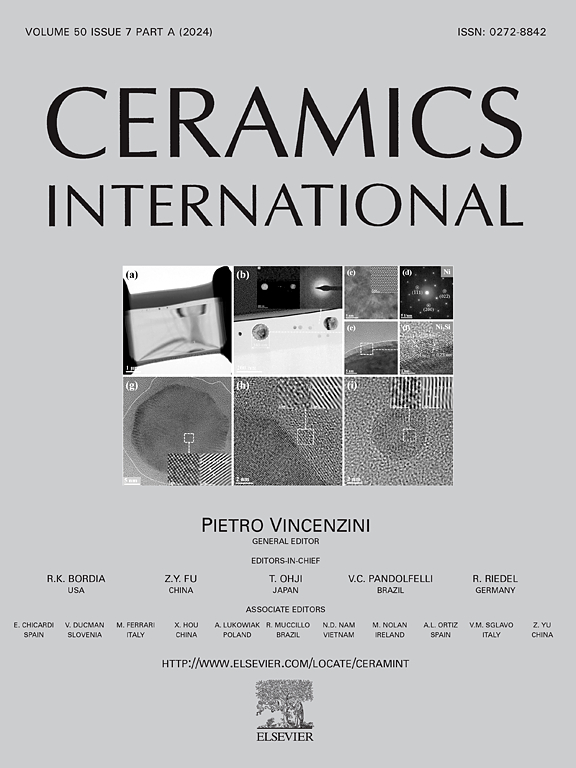基于超声振动效应的激光熔覆原位合成(Nb,Ta)C的均匀分布及热腐蚀行为
IF 5.6
2区 材料科学
Q1 MATERIALS SCIENCE, CERAMICS
引用次数: 0
摘要
为了解决原位合成(Nb,Ta)C在激光熔覆过程中的分层和聚集问题,采用超声振动抑制和断裂陶瓷相,提高了整体均匀分布和表面性能。系统研究了超声振动对孔隙率、表面形貌、微观结构和相演化的调节机理。深入揭示了(Nb,Ta)C陶瓷相的生长抑制、生长破碎和均匀分布演化过程。建立了热腐蚀行为与(Fe,Ni)相和(Nb,Ta)C相显微组织演变的关系。结果表明:超声振动均匀分布处理后,孔隙面积百分比由2.67%降低到0.24%,表面粗糙度和波动程度均有所降低;微米(Nb,Ta)C被抑制并破碎成亚微米大小,均匀分布在晶粒之间,从而提高了涂层的表面硬度和整体硬度均匀性。窄晶界(包括亚晶界)和均匀分布的亚微米(Nb,Ta)C共同阻碍了氧元素的内部膨胀,导致氧化层厚度从286 μm减小到43 μm。本文章由计算机程序翻译,如有差异,请以英文原文为准。
Uniform distribution and thermal corrosion behavior of in-situ synthesized (Nb,Ta)C by laser cladding based on ultrasonic vibration effect
To solve the issue of delamination and aggregation of in-situ synthesized (Nb,Ta)C during the laser cladding, ultrasonic vibration was employed to suppress and fracture the ceramic phase, enhancing the overall uniform distribution and surface property. The regulation mechanism of ultrasonic vibration on pore porosity, surface morphology, microstructure, and phase evolution has been systematically studied. The growth inhibition, growth fragmentation, and uniform distribution evolution process of (Nb,Ta)C ceramic phase have been deeply revealed. The correlation between thermal corrosion behavior and microstructure evolution, including (Fe,Ni) phase and (Nb,Ta)C ceramic phase, has been established. The results indicated that the pore area percentage decreases from 2.67 % to 0.24 %, and the surface roughness and fluctuation degree are reduced after uniform distribution treatment of ultrasonic vibration. Micron (Nb,Ta)C, which is suppressed and fragmented into submicron sizes, is uniformly distributed between grains, thereby enhancing the surface hardness and overall hardness uniformity of the coating. Narrow grain boundaries (including subgrain boundaries) and uniformly distributed submicron (Nb,Ta)C jointly hinder the internal expansion of oxygen element, causing the oxide layer thickness to decrease from 286 μm to 43 μm.
求助全文
通过发布文献求助,成功后即可免费获取论文全文。
去求助
来源期刊

Ceramics International
工程技术-材料科学:硅酸盐
CiteScore
9.40
自引率
15.40%
发文量
4558
审稿时长
25 days
期刊介绍:
Ceramics International covers the science of advanced ceramic materials. The journal encourages contributions that demonstrate how an understanding of the basic chemical and physical phenomena may direct materials design and stimulate ideas for new or improved processing techniques, in order to obtain materials with desired structural features and properties.
Ceramics International covers oxide and non-oxide ceramics, functional glasses, glass ceramics, amorphous inorganic non-metallic materials (and their combinations with metal and organic materials), in the form of particulates, dense or porous bodies, thin/thick films and laminated, graded and composite structures. Process related topics such as ceramic-ceramic joints or joining ceramics with dissimilar materials, as well as surface finishing and conditioning are also covered. Besides traditional processing techniques, manufacturing routes of interest include innovative procedures benefiting from externally applied stresses, electromagnetic fields and energetic beams, as well as top-down and self-assembly nanotechnology approaches. In addition, the journal welcomes submissions on bio-inspired and bio-enabled materials designs, experimentally validated multi scale modelling and simulation for materials design, and the use of the most advanced chemical and physical characterization techniques of structure, properties and behaviour.
Technologically relevant low-dimensional systems are a particular focus of Ceramics International. These include 0, 1 and 2-D nanomaterials (also covering CNTs, graphene and related materials, and diamond-like carbons), their nanocomposites, as well as nano-hybrids and hierarchical multifunctional nanostructures that might integrate molecular, biological and electronic components.
 求助内容:
求助内容: 应助结果提醒方式:
应助结果提醒方式:


